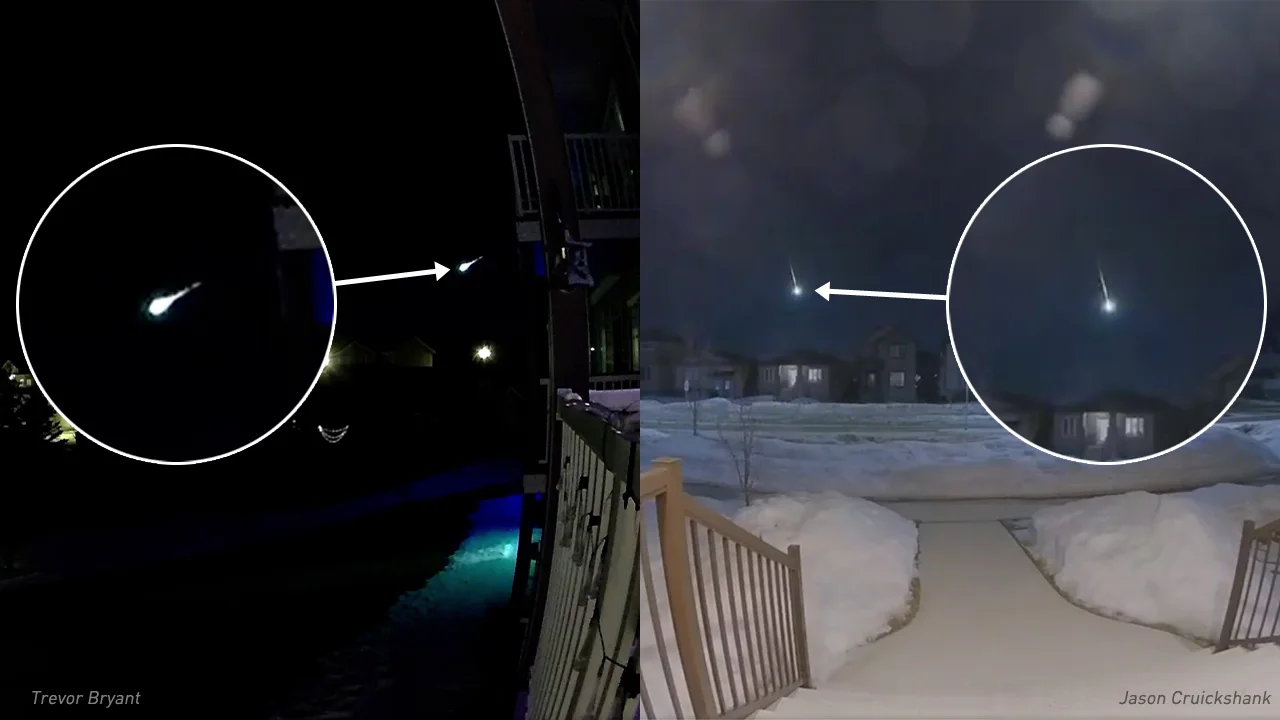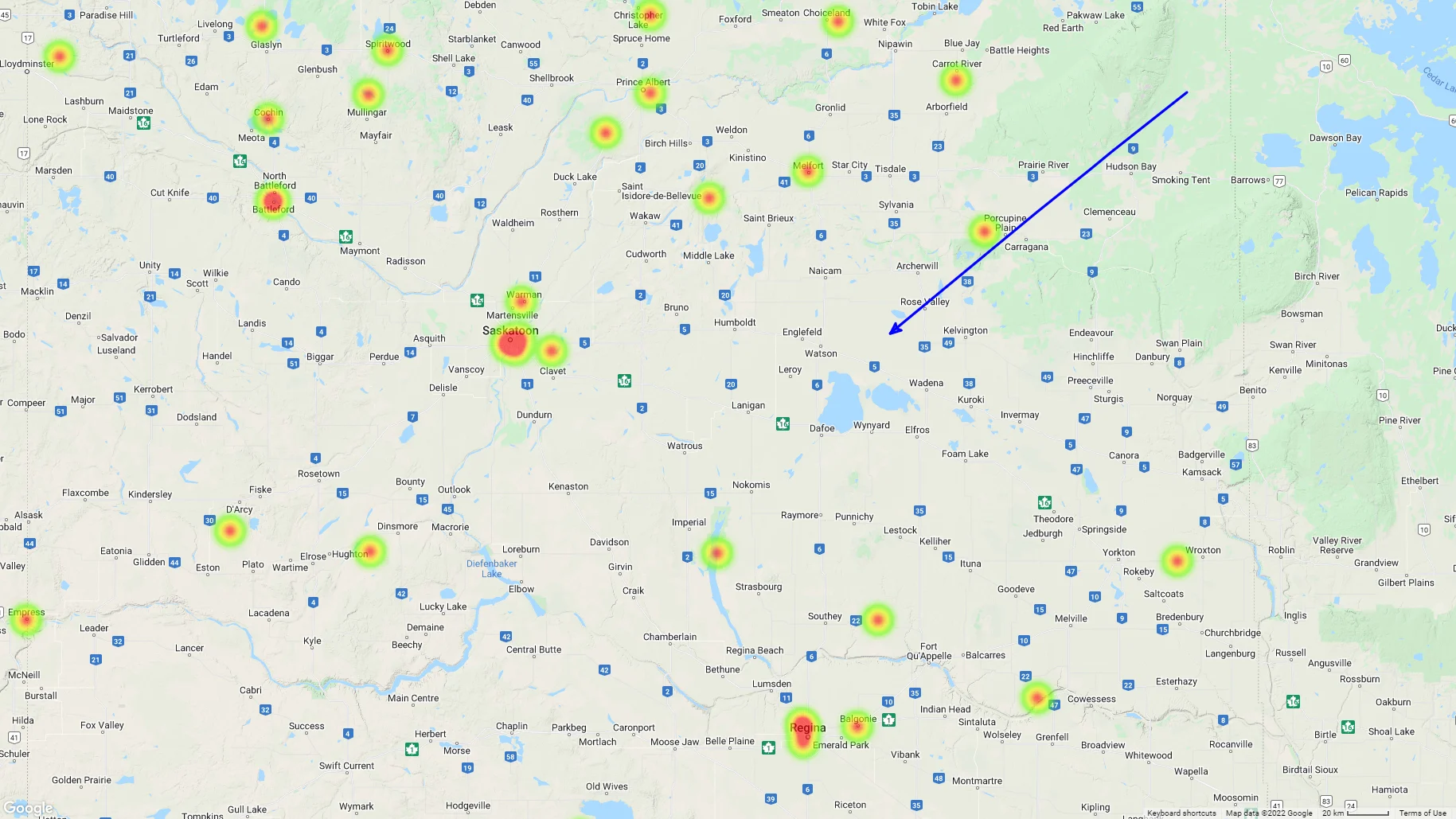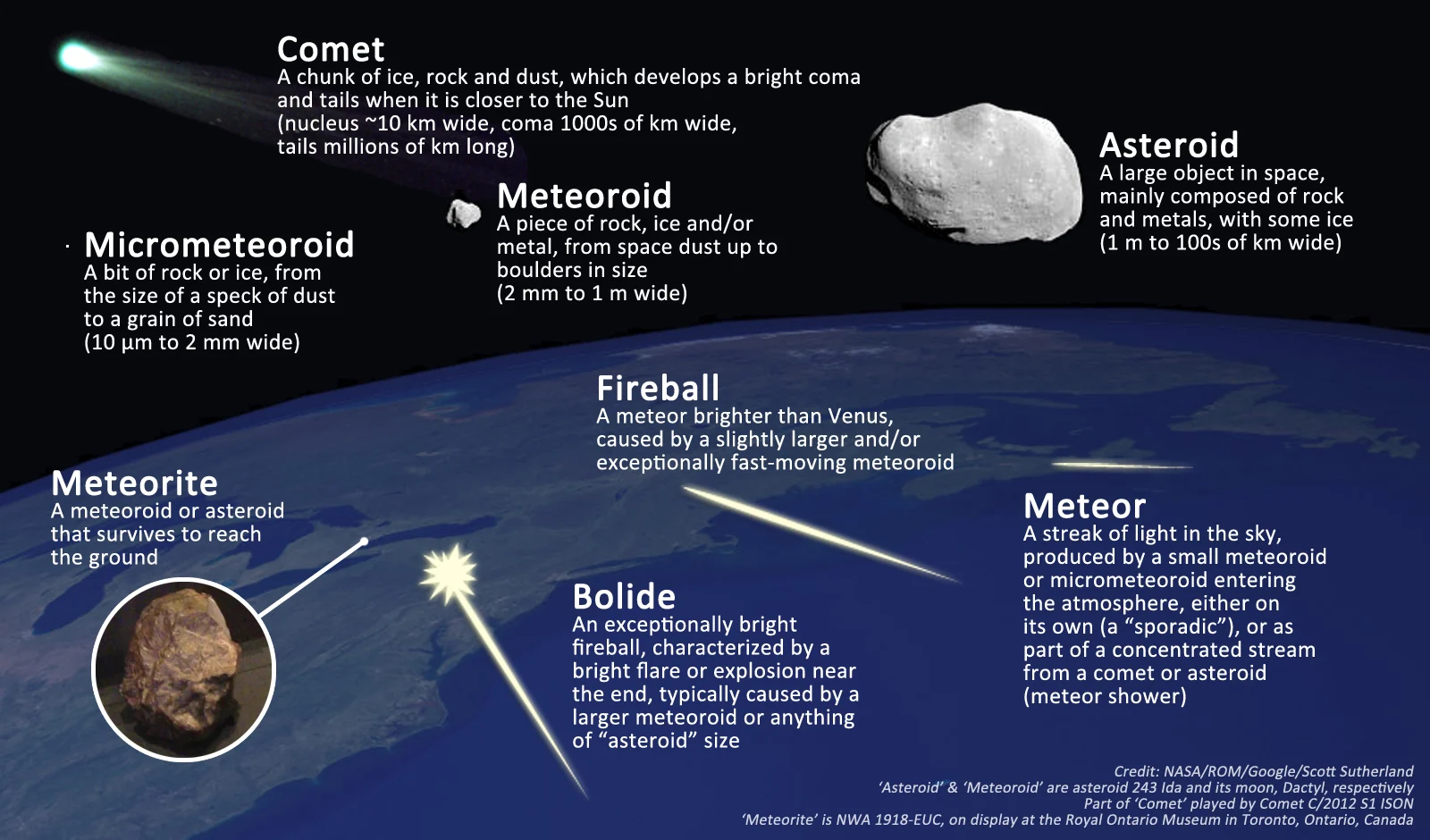
Two bright fireballs flashed over the Prairies, almost exactly one night apart
The 'once in a lifetime' meteor, seen from Manitoba and Saskatchewan on Tuesday night, was followed up by another over nearly the same area, almost exactly 24 hours later.
They came from completely different parts of the sky. Still, one night apart — nearly down to the minute — two bright meteor fireballs flashed over the Prairie provinces this week.
At 9:48 p.m. Central Time, on the night of Tuesday, March 22, witnessed spied a very bright meteor streaking across the sky.
According to the American Meteor Society, the fireball began around 40 kilometres north of Erwood, SK, just east of Highway 9 in the eastern part of the province. Then, for about 5 seconds, it blazed towards the southwest before winking out at a point just west of Fosston, SK, nearly 200 kilometres away.

This map from the American Meteor Society plots the track of the March 22, 2022 fireball over southeastern Saskatchewan (blue arrow). The coloured splotches indicate the "heat map" of observers, with darker colours representing a higher concentration of witnesses who reported the event. Credit: AMS
Based on witness reports, the event was seen as far away as North Dakota, southern Manitoba, and northern Saskatchewan. Even someone from the village of Empress, on the border between Saskatchewan and Alberta, spotted it.
Storm spotter Nick Schenher captured the fireball on his front door camera from Regina, SK.
If that wasn't amazing enough, the very next night, on Wednesday, March 23, at nearly the same exact time — 9:47 p.m. CT — a second meteor fireball was spotted.
Unlike the one from the previous night, this meteoroid appeared to plunge almost directly downward from space. Based on this, it was entirely unrelated to Tuesday night's fireball, as the two originated from different points in space.
Alix and Jason Cruickshank caught this one on video from their home in Winnipeg, MB.
Fireballs like this are caused when pieces of rock or ice (meteoroids) plunge into Earth's atmosphere from space, travelling at speeds of up to hundreds of thousands of kilometres per hour. As it ploughs through the upper atmosphere, a meteoroid compresses the air in its path, which heats the air up so much that it glows. This results in the meteor flash we see in the sky. Given that they occur at altitudes of 50 to 80 km above the ground, a particularly bright flash is typically visible for hundreds of kilometres around.
The meteor flash ends either when the meteoroid is completely vaporized by the heat or when the meteoroid slows enough that it can no longer compress the air to the point of incandescence.
WHAT ARE THE ODDS?
Seeing Tuesday night's meteor fireball was rare enough.
"A fireball this big and bright is exceptionally rare for a person to see," Scott Young, the planetarium astronomer at the Manitoba Museum, told CBC Manitoba on Wednesday.
"If you're a devoted sky watcher and you spend your whole life, you might be lucky to see two. But I mean, it really is a once-in-a-lifetime event."
Witnessing two fireballs from the same location, on two nights in a row... that has to be exceptionally rare. Right?
Based on the American Meteor Society reports, only one person of the 45 witnesses who saw the Tuesday night fireball — Trevor Bryant, from Brandon, MB — also managed to spot evidence of the Wednesday night event.
Bryant's webcam captured a great view of the first fireball (embedded below). However, it only managed to record an extremely brief flash of light from the second, as the meteor occurred outside the camera's point of view.
Watch below: See the March 22 Saskatchewan fireball, as seen from Brandon, MB (at 0:23 of the video)
Witnessing a fireball isn't just a matter of being outside and looking up.
Fireballs occur randomly, so they can happen at any time (but more on that below). First, it needs to be dark enough to see it, or the fireball has to be bright enough to spot in the light of day. Second, your timing of exactly where you are looking needs to be spot on. These events are here and gone in just a matter of seconds. So, even looking down at your cellphone, turning your head to talk to someone, or moving so a building or trees suddenly block your view of that exact part of the sky could cause you to miss it. Third, you actually need to be able to see the open sky. Clouds in the area could cause even a super-bright fireball to go unnoticed.
So, seeing two meteors like this, almost exactly one night apart, is remarkable.
However, according to Denis Vida, a meteor physics postdoctoral researcher at Western University, the timing of these two may not be all that rare after all.
In an email to The Weather Network, Vida pointed to research written back in 1982 by Canadian meteor astronomers Ian Halliday and Arthur Griffin.
In their paper, Halliday and Griffin gathered what we knew at the time about where meteorites come from — the typical orbits that meteoroids follow around the Sun before they hit Earth. They then used that information to determine when we are most likely to see these meteorite falls, based on the season, the time of day, and our latitude.
Summing up the results, Vida said that "we'll observe the greatest number of falls during the spring, between sundown and 12 a.m."
Given that we are just days after the spring equinox, Vida added, we are right at the peak of yearly meteorite fall activity. Plus, when these two fireballs were seen, right around 9:47 p.m. local time, is also right around the peak time of day for this latitude on Earth.
Related: Got your hands on a space rock? Here's how to know for sure
COULD THERE BE METEORITES?
The typical meteor flash in the sky is caused by a micrometeoroid — probably about the size of a grain of sand — which tends to completely vapourize when it hits the atmosphere. Bright fireballs like these two, on the other hand, are produced by larger objects. The larger a meteoroid is, and the slower it travels through the atmosphere, the greater the chance that part of it could survive to reach the ground.
That's when there's a possibility of finding meteorites.

According to Vida, simply based on how long the two fireballs last, it's possible that perhaps around 100 grams of meteorites may have hit the ground from each. However, more analysis would be necessary to know for sure.
Finding meteorites in Canada is often quite difficult, though. Snow on the ground can make this easier. The scorched black exterior typical of meteorites stands out quite well against the white surface. However, in areas with plenty of trees and underbrush, locating them can be a challenge.
Related: Want to find a meteorite? Expert Geoff Notkin tells us how!
If you think you may have found one, here's what to look for:
Look for the black exterior, the "fusion crust" that develops due to the heat from its passage through the atmosphere
See if it is magnetic. Even an ordinary fridge magnet will tend to stick to a meteorite
Beware of 'meteor-wrongs' such as industrial slag, which can have some characteristics of meteorites but are definitely from here on Earth.
Did you see either of these bright fireballs? If so, report what you witnessed to either the American Meteor Society or the International Meteor Organization. Every eyewitness report helps refine the path of these meteors, improve the science of meteors and fireballs, and potentially even help locate meteorites for study.






